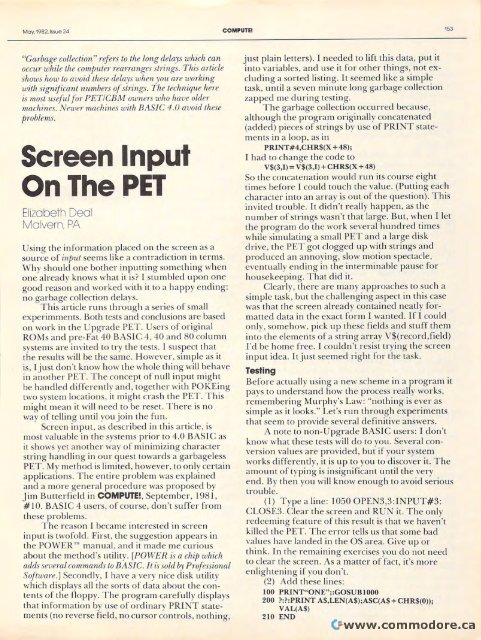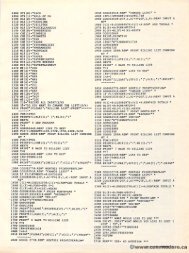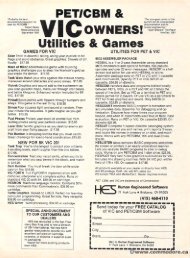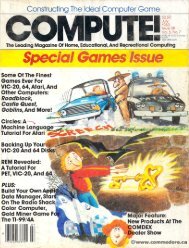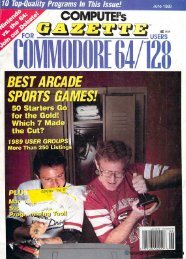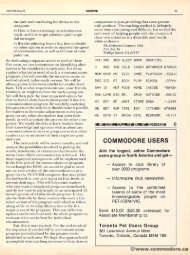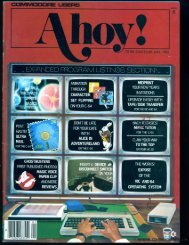You also want an ePaper? Increase the reach of your titles
YUMPU automatically turns print PDFs into web optimized ePapers that Google loves.
tvk:rv. 1Q82.lssue 24 COMPUTEI 153<br />
Moy. 1982. Issue 24 COMPUTE! 153<br />
"Garbage collection" reJers 10 the Long deLa.ys which can<br />
"Garbage collection" refers to the long delays which can<br />
occur while whiLe the computer cOllllmler rearranges strings. slrings. This is article (".tieLe<br />
shows how to 10 avoid these lhesf delays dela)'.' when you are a.re working<br />
riling<br />
with significant numbers of strings. The Th.e technique "~clmiq/l (J here h(lre<br />
is most lIIosllIseJll1 useful for J01' PET/CBM owners who have alder older<br />
machines. lIIachines. Newer machines with wilh BASIC 4.0 avoid these Ih ese<br />
problems. Inob/ellls.<br />
Screen Input<br />
Screen Input<br />
On The PET<br />
On The PET<br />
Elizabeth Deal<br />
Elizabeth Dea<br />
Malvern, PA<br />
Usin g the information placed on the screen as a<br />
Using the information placed on the screen as a<br />
source ofo f input inpul seems like a contradiction contradicLion in terms.<br />
Why should one bother inputting something when<br />
' Nh y should one bothe r inputtin g somethi ng when<br />
one alread y knows what it is' I stumbled upon one<br />
one already knows what it is? I stumbled upon one<br />
good reason and worked with it to a happy py ending:<br />
no garbage collecti on delays.<br />
no garbage collection delays.<br />
ThisT article runs through a series ofo f small<br />
experimments. Both BOlh tests and conclusions are based<br />
on work in the Upgrade PET. Users of ori gi nal<br />
on work in the Upgrade PET. Users of original<br />
ROMs and pre-Fat40 BASIC 4, 40 and 80 column<br />
systems are invited to try the tests. I suspect that<br />
the results will be the same. However, simple as it<br />
is, I just don't know how the whole thing will behave<br />
in anotherr PET. The concept of null input might<br />
be handled differently Ffe and, together with POKEing<br />
two system locations, it might crash the PET. This<br />
two system locations, it mi ght cras h the PET. T hi s<br />
mi ght mean it will need to be reset. There is no<br />
might mean it will need to be reset. There is no<br />
way of telling until you join the fun.<br />
Screen input, as described in thiss article, is<br />
most valuable in thee systems prior to 4.0 BASIC as<br />
it shows yet anotherr way of minimizingg characterr<br />
string handlingg in our questt towards a garbageless<br />
PET. My method is limited , however, to onl y certain<br />
PET. My method is limited, however, to only certain<br />
applications. The entire problem was explained<br />
ed<br />
a nd a more gene ral proced u re was proposed by<br />
and a more general procedure was proposed by<br />
Jim Butterfield in COMPUTE!, September, 1981, 1,<br />
##10. I O. BASICC 4 users, ooff course, don't sufferr fromm<br />
these problems.<br />
T he reason I became inte rested in screen<br />
The reason I became interested in screen<br />
input is twofold. . First. First, the suggestion aappears in<br />
the POWERW E R T~<br />
manual, aand it made me curious<br />
about the method's mutility. [POWER is a chil) chip which<br />
add, several commands 10 BASIC. It is sold b), ProJessional<br />
adds several commands to BASIC. It is sold by Professional<br />
SoJlware.] Software.] Secondly, I have a very nice ddisk utility<br />
which displays all the sorts of data about the con<br />
tents ooff the noppy. floppy. TThe program carefullyy displays<br />
that information by use of ordinary PRIXT NT state tements<br />
(no reverse fi eld , no cursor controls, nothing,<br />
ments (no reverse field, no cursor controls, nothing.<br />
just plain letters). I needed to lift this data, put it<br />
just plain letters). I needed to lift this data, put it<br />
into va riabl es, a nd use it for other things, not ex<br />
into variables, and use it for other things, not ex<br />
cluding a sorted n listing. It seemed like a simple<br />
task, until a seven minute long garbage collection<br />
tas k, until a seven minute lo ng garbage colleclion<br />
za pped me duri ng testing.<br />
zapped me during testing.<br />
The T garbage collection<br />
occurred because,<br />
although the program originally concatenated<br />
although the program ori ginall y concatenated<br />
(added) ) pieces of strings by use ofo f PRINT I statements<br />
in a loop, as in<br />
ments in a loop, as in<br />
PRINT#4,CHR$(X + +48);<br />
I had to change the code to<br />
I had to change the code to<br />
V$


